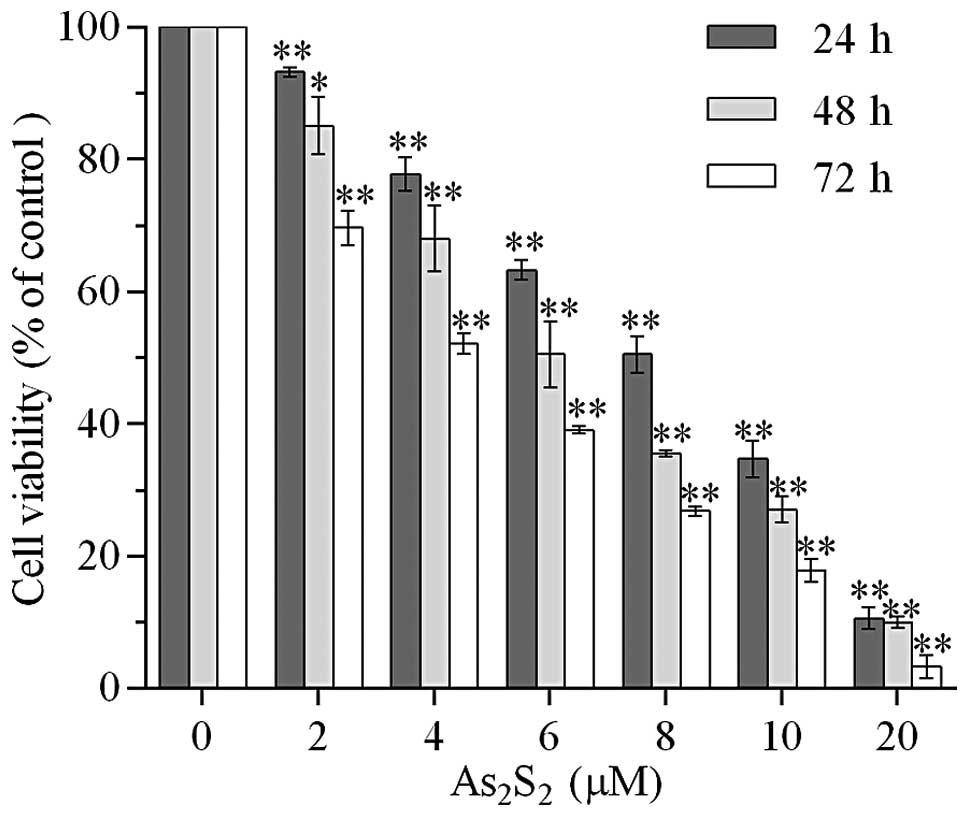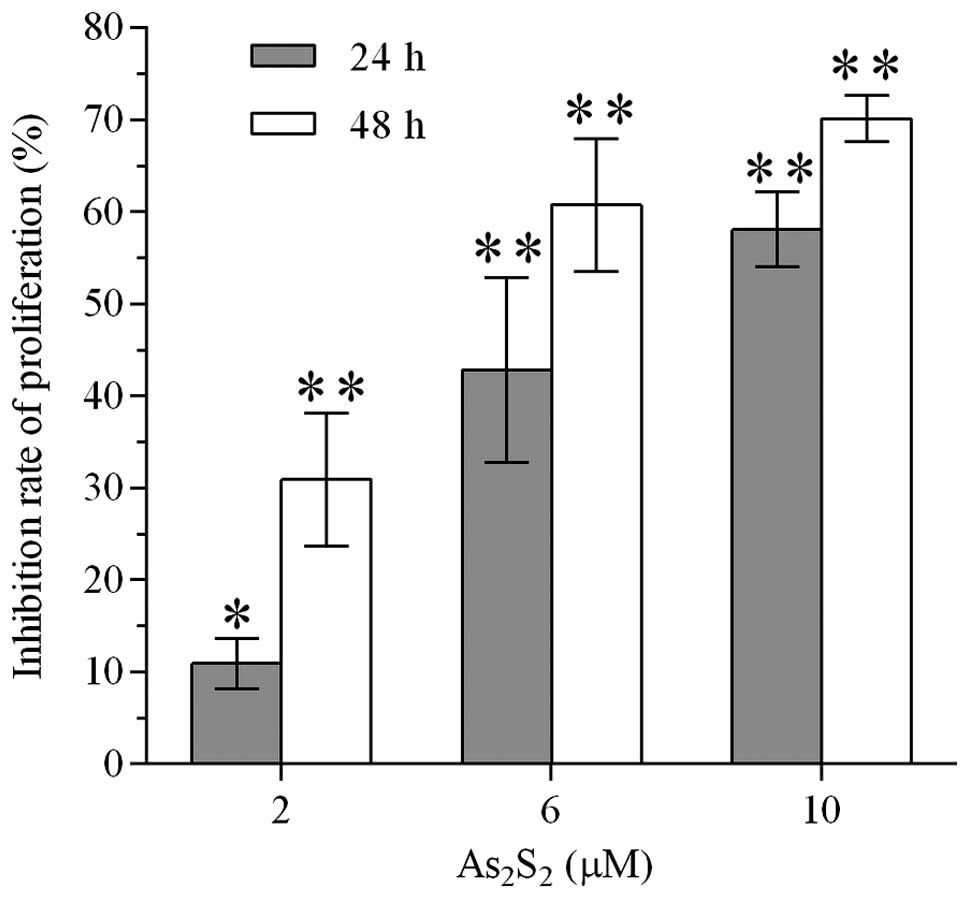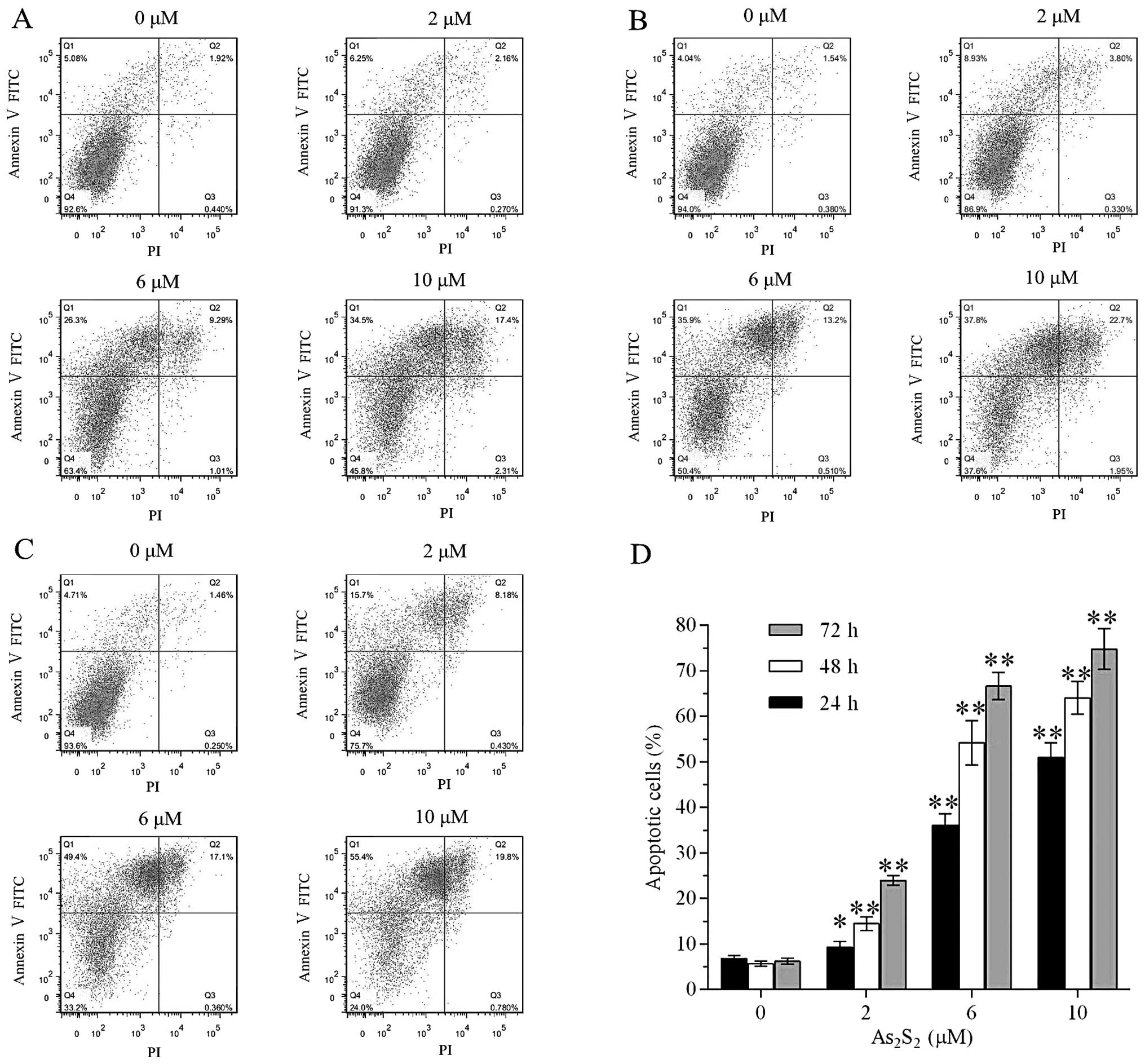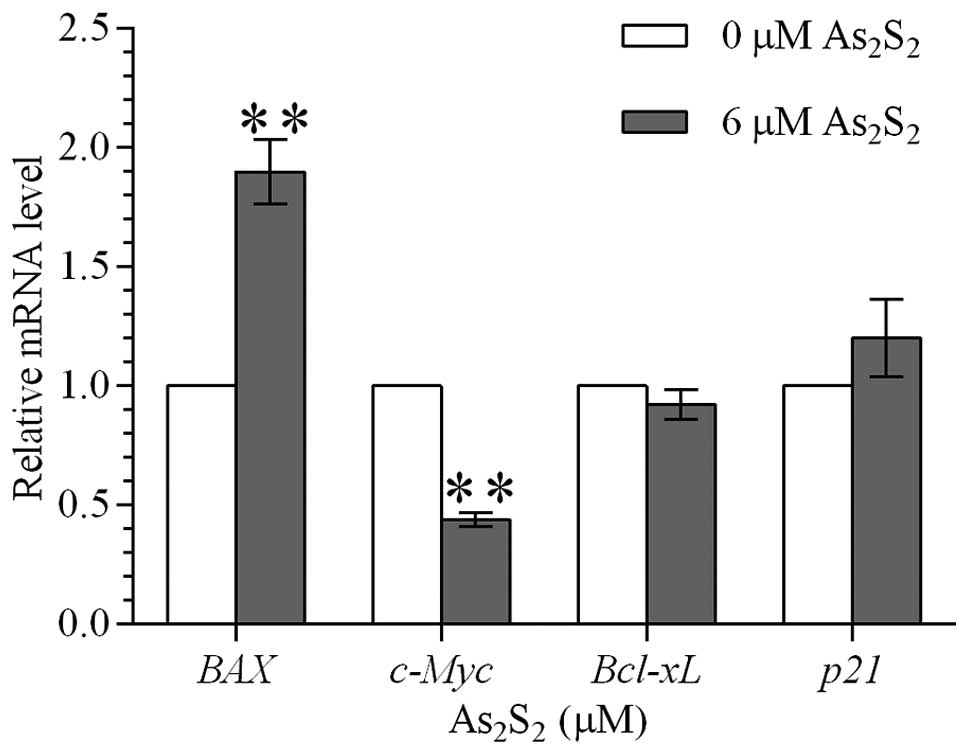Realgar induces apoptosis in the chronic lymphocytic leukemia cell line MEC‑1
- Authors:
- Published online on: October 14, 2013 https://doi.org/10.3892/mmr.2013.1731
- Pages: 1866-1870
Abstract
Introduction
Traditional Chinese medicine (TCM) has been used as effective antitumor agents for numerous years in ancient China (1). However, it is difficult to identify the active ingredient due to the complex composition. Thus, the use of TCM has been severely restricted in clinical practices following the introduction of western antineoplastic methods, including radiotherapy and chemotherapy. The therapeutic efficacy of arsenic trioxide (As2O3) has been shown previously in the treatment of acute promyelocytic leukemia (APL), of which the mechanism has also been identified (2–6). Consequently, TCM has become an important area of study again and attracted considerable attention in aspects of cancer treatment, particularly in the treatment of malignant hematologic diseases. Numerous studies have been conducted thus far, yielding a number of achievements (7–11).
As2O3 and realgar (arsenic sulfide, As2S2) belong to a group of Chinese arsenic drugs (12) and have a number of similarities. For example, realgar and As2O3 exhibit a good antitumor effect. Realgar is the principal constituent in the Realgar-Indigo naturalis formula (RIF), together with Indigo naturalis, Salvia miltiorrhiza and Radix Pseudostellariae. RIF shows satisfactory efficacy in treating human APL (13). Realgar has also been shown to induce apoptosis of chronic myelogenous leukemia (CML) cells through the degradation of BCR-ABL(14,15). Results of recent studies have shown that As2O3 induced apoptosis of chronic lymphocytic leukemia (CLL) cells (16,17). This effect on CLL cells may be mediated by suppressing the phosphoinositide 3-kinase/Akt survival pathway via c-jun-NH2 terminal kinase activation and PTEN upregulation (17). However, whether realgar induces apoptosis of CLL cells remains unknown.
CLL is the most common adult leukemia in western countries. It is a highly heterogeneous disease. Immunoglobulin heavy chain variable mutation status, cytogenetic changes and expression of CD38 and ZAP-70 differ among patients. Although the survival rate of CLL has improved over the past decade, with the exception of allogeneic bone marrow transplantation, no treatment is sufficiently effective to completely cure the disease. Particularly for CLL with a 17p deletion, it is almost impossible to avoid deterioration. Therefore, the purpose of the present study was to investigate the effect of realgar on the viability, proliferation and apoptosis of the human p53deleted/mutated CLL cell line, MEC-1. In addition, the potential mechanism mediating the effect were explored during the study.
Materials and methods
Cell lines
Human p53deleted/mutated CLL cell line, MEC-1, was suspended in Iscove’s modified Dulbecco’s medium (IMDM; HyClone Laboratories, Inc., Logan, UT, USA) containing 10% fetal bovine serum (HyClone), 100 U/ml penicillin and 100 μg/ml streptomycin. Culturing conditions were maintained at 37°C in a humidified atmosphere containing 5% CO2.
Reagents
Realgar (purity, 99.53%) was purchased from Alfa Aesar (Ward Hill, MA, USA). It was dissolved in 0.1 M sodium hydroxide and the pH was adjusted to 7.35–7.45 using hydrochloric acid (14,18). The stock solution (1 mM As2S2) was then passed through a 0.22 μm filter. IMDM was used to dilute the solution prior to cell application.
Cell viability assay
A WST-8 assay kit (Beyotime Institute of Biotechnology, Jiangsu, China) was employed to evaluate the effect of realgar on cell viability. Logarithmically growing MEC-1 cells were seeded in a 96-well plate at a density of 1×104 cells/100 μl/well. The cells were incubated with increasing concentrations of realgar (0, 2, 4, 6, 8, 10 and 20 μM) for 24, 48 and 72 h. Subsequently, 10 μl WST-8 was added to each well and the cells were incubated for 4 h prior to cell viability measurements of absorbance at 450 nm. The inhibitory concentration of 50% of cells (IC50) was obtained using the probit regression analysis method. Three replicates were established for each sample.
5-Bromodeoxyuridine (BrdU) cell proliferation assay
A BrdU cell proliferation ELISA kit (Roche Diagnostics Co., Indianapolis, IN, USA) was used to evaluate the inhibitory effects of realgar on cell proliferation, according to the manufacturer’s instructions. MEC-1 cells with a density of 1×104 cells/ml were exposed to various concentrations (0, 2, 6 and 10 μM) of realgar for 24 and 48 h. BrdU (10 μl/well) was then added. Following incubation for an additional 2 h, the culture medium was removed and the cells were fixed. Following incubation with the antiBrdU-peroxidase for 1 h and the substrate reaction, 25 μl of 1 M H2SO4 was applied and the absorbance was read on an ELISA reader at 450 nm.
Annexin V-fluorescein isothiocyanate (FITC)/propidium iodide (PI) dual staining
Induction of apoptosis was assessed using an annexin V-FITC apoptosis detection kit (KeyGen Biotech Co., Ltd., Nanjing, China). MEC-1 cells were treated with 0, 2, 6 and 10 μM realgar. Dual staining with annexin V-FITC and PI was performed, according to the manufacturer’s instructions. Following incubation for 24, 48 or 72 h, 5–10×105 cells were collected, washed with PBS, stained with annexin V-FITC/PI and incubated for 10 min prior to analysis with a flow cytometer (Becton-Dickinson, San Jose, CA, USA). The data obtained were processed with FlowJo 7.6 software (TreeStar, Inc., Ashland, OR, USA). Annexin V-FITC- and PI-negative cells were identified as viable cells. Cells with annexin V-FITC-positive and PI-negative staining were considered to be early apoptotic cells while those with annexin V-FITC- and PI-positive staining were late apoptotic cells. The addition of early and late apoptotic cells constituted the apoptotic cells.
Gene expression study by quantitative polymerase chain reaction (PCR)
Transcriptional levels of BCL2-associated X protein (BAX), BCL2-like 1 (Bcl-xL), v-myc myelocytomatosis viral oncogene homolog (avian; c-Myc) and cyclin-dependent kinase inhibitor 1A (p21) genes, in realgar-treated and untreated MEC-1 cells, were evaluated by quantitative PCR. Total RNA was extracted by TRIzol reagent (Invitrogen Life Technologies, Carlsbad, CA, USA) from MEC-1 cells following incubation with 0 and 6 μM realgar for 48 h. Reverse transcription to complementary DNA (cDNA) was performed using PrimeScript RT reagent kit with gDNA eraser (Takara Biotechnology Co., Ltd., Dalian, China). Quantitative PCR for the aforementioned genes was performed using a SYBR Premix Ex Taq II (Tli RNase H Plus) kit (Takara Biotechnology Co., Ltd.) on a Roche LightCycler 480 (Roche Diagnostics Co.). Actin was used as an internal control. The sequences of the quantitative PCR primers are listed in Table I. Isolation of RNA, reverse transcription and quantitative PCR were performed following the manufacturer’s instructions. For data analysis the 2−ΔΔCt method was used with the following equations: ΔCt = Ct (target gene) − Ct (actin); ΔΔCt = ΔCt (realgar-treated cells) − ΔCt (untreated control). Quantitative PCR for each gene of each cDNA sample was assayed in triplicate.
Statistical analysis
Statistical analysis was performed using SPSS 17.0 (SPSS, Inc., Chicago, IL, USA). Data are expressed as mean ± SD. The significance of differences between groups was determined using the Student’s t-test or ANOVA. P<0.05 was considered to indicate a statistically significant difference.
Results
Realgar suppresses the viability of MEC-1 cells
The effect of realgar on cell viability of MEC-1 cells was evaluated using a WST-8 assay. The MEC-1 cells were incubated with various doses of realgar (0, 2, 4, 6, 8, 10 and 20 μM) for the time periods 24, 48 and 72 h. As shown in Fig. 1, treatment with 2 μM realgar for 24 h resulted in a 6.80±0.70% reduction of viable cells (P<0.01) compared with the control group. The inhibitory effect of cell viability was enhanced with an increased realgar dose and incubation time. The viability rate decreased to 69.67±2.63% when the treatment time increased to 72 h. There was a significant difference between the two 2 μM realgar-treated groups (P<0.01). In addition, 10.59±1.61% cells remained viable when exposed to 20 μM realgar for 24 h (P<0.01). The IC50 at 24, 48 and 72 h was 7.998, 6.380 and 6.219 μM, respectively.
Realgar inhibits the proliferation of MEC-1 cells
BrdU cell proliferation ELISA was performed to investigate whether realgar suppressed the proliferation of MEC-1 cells. The inhibition of the proliferation of MEC-1 cells occurred in a concentration- and time-dependent manner (Fig. 2). Treatment of MEC-1 cells with realgar at 2, 6 and 10 μM reduced the proliferation of MEC-1 cells by 5.68, 42.78 and 58.08% following 24 h and 30.90, 60.72 and 70.09% following 48 h, respectively.
Realgar induces apoptosis of MEC-1 cells
The apoptotic effect of realgar on MEC-1 cells was determined by annexin V-FITC/PI dual staining, followed by flow cytometry analysis. As shown in Fig. 3, apoptosis of MEC-1 cells was induced by realgar in a dose- and time-dependent manner. Following treatment with 2 μM realgar for 24 h, the percentage of apoptotic cells increased between 6.78±0.60 and 9.26±1.25% (P<0.05). With an increase in incubation time or concentration of realgar, the induction of apoptosis was significantly enhanced. Percentages of apoptotic cells, following incubation with 2 μM realgar for 48 h and 6 μM for 24 h, were 14.44±1.54 (P<0.01) and 36.09±2.48% (P<0.01), respectively.
Realgar upregulates mRNA levels of BAX while downregulating mRNA levels of c-Myc
To further investigate whether realgar-induced apoptosis was dependent on the mitochondrial apoptosis pathway, the effect of realgar on the mRNA levels of BAX, Bcl-xL, c-Myc and p21 genes was measured by quantitative PCR. Following treatment with 6 μM realgar for 48 h, mRNA expression of BAX in MEC-1 cells was upregulated almost 2-fold while c-Myc mRNA expression was reduced by more than half (Fig. 4). However, no significant difference in the expression of Bcl-xL and p21 was observed between the realgar-treated and untreated MEC-1 cells.
Discussion
Studies have been conducted on the antineoplastic effect of realgar. Realgar has been shown to have antiproliferative and pro-apoptotic effects on a number of cancer cell lines, including rat glioma C6 cells, mouse melanoma B16 cells and the cervical cancer cell line SiHa (19–21). More studies on the antineoplastic effect of realgar have been carried out in a few cells types of malignant hematologic diseases. The majority of these studies have focused on promyelocytic leukemia HL-60 cells, APL cell line NB4 and CML cell line K562, as well as peripheral blood or bone marrow cells gained from APL and CML patients. Consequently, considerable success has been achieved. Oxidative stress, membrane toxicity and protein tyrosine kinase may be involved in the process of realgar-induced apoptosis (14,22). Realgar has been reported to induce apoptosis in human histocytic lymphoma U937 cells through caspase, MAPK and mitochondrial pathways (23,24). However, no studies focusing on the effect of realgar on CLL cells have been conducted prior to this study.
CLL is a malignant disease of B lymphocytes, initially recognized as the result of accumulation of rest cells. However, CLL was later found to be a disease of activated monoclonal cells that proliferated in particular microenvironments (25,26). The molecular mechanism leading to the imbalance between apoptosis and proliferation has attracted considerable attention and associated pathways have been explored widely in order to identify new therapies targeted to cure CLL. In the present study, arsenic compound realgar was used to dispose MEC-1 cells. The MEC-1 cell line was established from the peripheral blood of a CLL patient in prolymphocytoid transformation (27). Several cytogenetic aberrations were detected, including del(17)(p11.2pter) (27). It was found that realgar, not only suppressed viability and proliferation, but also induced apoptosis of MEC-1 cells.
Further investigations were performed analyzing the effect various doses and incubation times had on MEC-1 cells. Following exposure to various concentrations of realgar for different time periods, cell viability and proliferation were inhibited in MEC-1 cells in a dose- and time-dependent manner. The effect of realgar on apoptosis was also evaluated in MEC-1 cells and found to induce apoptosis in a dose- and time-dependent manner.
Potential mechanisms involved in the realgar-induced apoptosis were explored. mRNA expression of BAX and c-Myc was upregulated and downregulated, respectively, following realgar treatment. BAX belongs to the Bcl-2 family of pro-apoptotic genes and is an important member of the mitochondrial apoptosis pathway (28). Protein encoded by the c-Myc gene functions as a transcription factor that participates in significant processes, including cell cycle progression, apoptosis and cell transformation. Changes in mRNA expression levels of BAX and c-Myc indicated that realgar-induced apoptosis of MEC-1 cells may be dependent on the mitochondrial pathway.
In summary, the inhibitory effect of realgar on the CLL cell line, to the best of our knowledge, was explored for the first time. Based on the findings of the present study, it may be concluded that realgar inhibited viability and proliferation and induced apoptosis of MEC-1 cells in a dose- and time-dependent manner. This phenomenon may depend on the mitochondrial apoptosis pathway, as the upregulation of BAX expression and downregulation of c-Myc expression was observed in MEC-1 cells following realgar treatment. The results of the present study may be beneficial for the identification of a new target therapy for CLL. In addition, more studies are required to explore the detailed mechanism involved in the process.
Acknowledgements
The study was supported by grants from the National Natural Science Foundation (no. 81270598), Natural Science Foundations of Shandong Province (nos. Y2007C053, 2009ZRB14176 and ZR2012HZ003), Technology Development Projects of Shandong Province (nos. 2007GG10 and 2010GSF10250) and the Program of Shandong Medical Leading Talent and Taishan Scholar Foundation of Shandong Province.
Abbreviations:
|
TCM |
traditional Chinese medicine |
|
As2O3 |
arsenic trioxide |
|
APL |
acute promyelocytic leukemia |
|
As2S2 |
realgar, arsenic sulfide |
|
CML |
chronic myelogenous leukemia |
|
CLL |
chronic lymphocytic leukemia |
|
IMDM |
Iscove’s modified Dulbecco’s medium |
|
IC50 |
inhibitory concentration of 50% |
|
BrdU |
5-bromodeoxyuridine |
|
FITC |
fluorescein isothiocyanate |
|
PI |
propidium iodide |
|
cDNA |
complementary DNA |
References
|
Man S, Gao W, Wei C and Liu C: Anticancer drugs from traditional toxic Chinese medicines. Phytother Res. 26:1449–1465. 2012.PubMed/NCBI | |
|
Soignet SL, Maslak P, Wang ZG, et al: Complete remission after treatment of acute promyelocytic leukemia with arsenic trioxide. N Engl J Med. 339:1341–1348. 1998. View Article : Google Scholar : PubMed/NCBI | |
|
Lu J, Chew EH and Holmgren A: Targeting thioredoxin reductase is a basis for cancer therapy by arsenic trioxide. Proc Natl Acad Sci USA. 104:12288–12293. 2007. View Article : Google Scholar : PubMed/NCBI | |
|
Hu J, Liu YF, Wu CF, et al: Long-term efficacy and safety of all-trans retinoic acid/arsenic trioxide-based therapy in newly diagnosed acute promyelocytic leukemia. Proc Natl Acad Sci USA. 106:3342–3347. 2009. View Article : Google Scholar : PubMed/NCBI | |
|
Kim J, Lee JJ, Kim J, Gardner D and Beachy PA: Arsenic antagonizes the Hedgehog pathway by preventing ciliary accumulation and reducing stability of the Gli2 transcriptional effector. Proc Natl Acad Sci USA. 107:13432–13437. 2010. View Article : Google Scholar : PubMed/NCBI | |
|
Zhang XW, Yan XJ, Zhou ZR, et al: Arsenic trioxide controls the fate of the PML-RARalpha oncoprotein by directly binding PML. Science. 328:240–243. 2010. View Article : Google Scholar : PubMed/NCBI | |
|
Mahieux R, Pise-Masison C, Gessain A, et al: Arsenic trioxide induces apoptosis in human T-cell leukemia virus type 1- and type 2-infected cells by a caspase-3-dependent mechanism involving Bcl-2 cleavage. Blood. 98:3762–3769. 2001. View Article : Google Scholar | |
|
Bae-Jump VL, Zhou C, Boggess JF and Gehrig PA: Arsenic trioxide (As2O3) inhibits expression of estrogen receptor-alpha through regulation of the mitogen-activated protein kinase (MAPK) pathway in endometrial cancer cells. Reprod Sci. 15:1011–1017. 2008. | |
|
Kang YH and Lee SJ: The role of p38 MAPK and JNK in Arsenic trioxide-induced mitochondrial cell death in human cervical cancer cells. J Cell Physiol. 217:23–33. 2008. View Article : Google Scholar : PubMed/NCBI | |
|
Ahn RW, Chen F, Chen H, et al: A novel nanoparticulate formulation of arsenic trioxide with enhanced therapeutic efficacy in a murine model of breast cancer. Clin Cancer Res. 16:3607–3617. 2010. View Article : Google Scholar : PubMed/NCBI | |
|
Raju GP: Arsenic: a potentially useful poison for Hedgehog-driven cancers. J Clin Invest. 121:14–16. 2011. View Article : Google Scholar : PubMed/NCBI | |
|
Hu XM, Liu F and Ma R: Application and assessment of Chinese arsenic drugs in treating malignant hematopathy in China. Chin J Integr Med. 16:368–377. 2010. View Article : Google Scholar : PubMed/NCBI | |
|
Xiang Y, Wang XB, Sun SJ, et al: Compound huangdai tablet as induction therapy for 193 patients with acute promyelocytic leukemia. Zhonghua Xue Ye Xue Za Zhi. 30:440–442. 2009.(In Chinese). | |
|
Li JE, Wu WL, Wang ZY and Sun GL: Apoptotic effect of As2S2 on K562 cells and its mechanism. Acta Pharmacol Sin. 23:991–996. 2002. | |
|
Mao JH, Sun XY, Liu JX, et al: As4S4 targets RING-type E3 ligase c-CBL to induce degradation of BCR-ABL in chronic myelogenous leukemia. Proc Natl Acad Sci USA. 107:21683–21688. 2010.PubMed/NCBI | |
|
Bairey O, Vanichkin A and Shpilberg O: Arsenic-trioxide-induced apoptosis of chronic lymphocytic leukemia cells. Int J Lab Hematol. 32(1 Pt 1): e77–e85. 2010. View Article : Google Scholar : PubMed/NCBI | |
|
Redondo-Muñoz J, Escobar-Díaz E, Hernández Del Cerro M, et al: Induction of B-chronic lymphocytic leukemia cell apoptosis by arsenic trioxide involves suppression of the phosphoinositide 3-kinase/Akt survival pathway via c-jun-NH2 terminal kinase activation and PTEN upregulation. Clin Cancer Res. 16:4382–4391. 2010.PubMed/NCBI | |
|
Yin T, Wu YL, Sun HP, et al: Combined effects of As4S4 and imatinib on chronic myeloid leukemia cells and BCR-ABL oncoprotein. Blood. 104:4219–4225. 2004. | |
|
Zhao QH, Zhang Y, Liu Y, et al: Anticancer effect of realgar nanoparticles on mouse melanoma skin cancer in vivo via transdermal drug delivery. Med Oncol. 27:203–212. 2010. View Article : Google Scholar : PubMed/NCBI | |
|
An YL, Nie F, Wang ZY and Zhang DS: Preparation and characterization of realgar nanoparticles and their inhibitory effect on rat glioma cells. Int J Nanomedicine. 6:3187–3194. 2011. View Article : Google Scholar : PubMed/NCBI | |
|
Cheng YX, Liu R, Wang Q, et al: Realgar-induced apoptosis of cervical cancer cell line Siha via cytochrome c release and caspase-3 and caspase-9 activation. Chin J Integr Med. 18:359–365. 2012. View Article : Google Scholar : PubMed/NCBI | |
|
Ye HQ, Gan L, Yang XL and Xu HB: Membrane-associated cytotoxicity induced by realgar in promyelocytic leukemia HL-60 cells. J Ethnopharmacol. 103:366–371. 2006. View Article : Google Scholar : PubMed/NCBI | |
|
Wang XB, Gao HY, Hou BL, Huang J, Xi RG and Wu LJ: Nanoparticle realgar powders induce apoptosis in U937 cells through caspase MAPK and mitochondrial pathways. Arch Pharm Res. 30:653–658. 2007. View Article : Google Scholar : PubMed/NCBI | |
|
Xi RG, Huang J, Li D, Wang XB and Wu LJ: Roles of PI3-K/Akt pathways in nanoparticle realgar powders-induced apoptosis in U937 cells. Acta Pharmacol Sin. 29:355–363. 2008. View Article : Google Scholar : PubMed/NCBI | |
|
Klein U and Dalla-Favera R: New insights into the pathogenesis of chronic lymphocytic leukemia. Semin Cancer Biol. 20:377–383. 2010. View Article : Google Scholar : PubMed/NCBI | |
|
Damle RN, Calissano C and Chiorazzi N: Chronic lymphocytic leukaemia: a disease of activated monoclonal B cells. Best Pract Res Clin Haematol. 23:33–45. 2010. View Article : Google Scholar : PubMed/NCBI | |
|
Stacchini A, Aragno M, Vallario A, et al: MEC1 and MEC2: two new cell lines derived from B-chronic lymphocytic leukaemia in prolymphocytoid transformation. Leuk Res. 23:127–136. 1999. View Article : Google Scholar : PubMed/NCBI | |
|
Buggins AG and Pepper CJ: The role of Bcl-2 family proteins in chronic lymphocytic leukaemia. Leuk Res. 34:837–842. 2010. View Article : Google Scholar : PubMed/NCBI |













